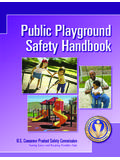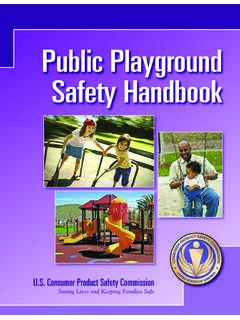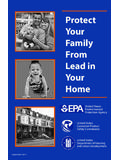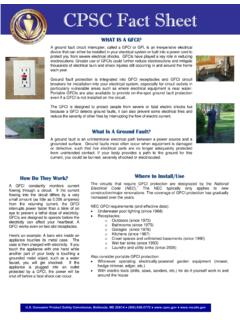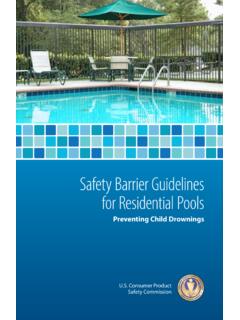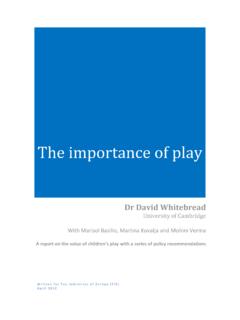Transcription of Outdoor Home Plaground y Safety Handbook - cpsc.gov
1 Outdoor Home Playground Safety Handbook Consumer Product Safety Commission Bethesda, MD. Table of Contents Introduction Outdoor Home Playground Safety .. 1. 1. Plan Your play Area .. 2. 2. Pick the Right Construction Materials.. 2. 3. Anchor, Assemble, and Maintain Your Equipment.. 4. 4. Select Protective Surfacing.. 5. 5. Prevent Head and Neck Entrapment .. 7. 6. Eliminate Hanging Ropes .. 8. 7. Protect Against Falls .. 8. 8. Use Toddler/Tot Swings Safely.. 10. Outdoor Home Playground Safety Checklist.. Inside Back Cover Outdoor Home Playground Safety Handbook i Playground Equipment Manufacturers, Builders and Installers The Standard Consumer Safety Performance Specification for Home Playground Equipment, ASTM F1148 contains technical provisions for the performance and design of home playground equipment. Protective surfacing requirements can be found in ASTM F1292, Standard Specification for Impact Attenuation of Surfacing Materials within the Use Zone of Playground Equipment.
2 These standards can be ordered from ASTM International at www. or call 610-832-9585. In July 2009, ASTM International published a revision to the standard for home playground equipment, Standard Consumer Safety Performance Specification for Home Playground Equipment, ASTM F1148-09. This revised Safety standard prohibits the attachment of components such as swings, gliders and trapeze bars from monkey bars. This change in home playground design will reduce the likelihood of children falling from the monkey bars onto the swinging components and is applicable to all future production of Outdoor play /gym sets. For older equipment, the Consumer Product Safety Commission ( cpsc ) reminds parents to remove swings and other suspended components that are attached to monkey bars to lessen the chance that children will be hurt by a fall from the bars. Outdoor Home Playground Safety If you have playground equipment in your backyard, you'll want to make it a fun and safe place for kids to play .
3 Unfortunately, injuries on home playgrounds can be more than just scraped knees or minor bruises. Each year, about 50,000 children go to hospital emergency rooms because of injuries on home playground equipment. About 80% of the injuries occur when children fall from play equipment. Children are also injured when they are hit by swings or other moving equipment or are cut from sharp edges and protruding bolts on play structures. In addition, each year several children die on home playgrounds. These deaths often result when children get entangled in and strangle from ropes, cords, or leashes attached to play equipment, or when clothing drawstrings and items worn around children's necks catch on the equipment. Others die when their heads or necks are trapped in narrow spaces, they fall from the equipment, or when they are struck by play equipment that moves or tips over. The good news is that you can help prevent many of these injuries. This Handbook , developed by the Consumer Product Safety Commission ( cpsc ), highlights the most important Safety information you need to know about planning, constructing, and maintaining an Outdoor home playground.
4 The most important Safety tips for setting up a home playground as well as a simple reminder to supervise children and teach them how to play appropriately on the equipment are in the Outdoor Home Playground Safety Checklist inside the back cover. The Handbook is not a mandatory standard. The information provided is not intended as the sole method to reduce injuries associated with playground equipment. The Commission believes, however, that the recommendations in this Handbook will contribute to greater equipment Safety . This Handbook is intended as guidance for homes and residential child care facilities. Schools, parks, multiple family dwellings, public child care facilities, restaurants and recreational developments, and other public use facilities should reference the Handbook for Public Playground Safety , cpsc . publication number 325. The publication is available on the cpsc website, Outdoor Home Playground Safety Handbook 1. 1. Plan Your play Area Choosing a Site When you plan a home playground, a location away from roads and driveways and readily visible from inside the home and patios or porches, is important.
5 So, keep the following points in mind: Create a site free of obstacles that could cause injuries such as low overhanging tree branches, overhead wires, tree stumps and/or roots, large rocks, bricks, and concrete. Choose a level location for the equipment. This can reduce the likelihood of the play set tipping over and loose-fill surfacing materials washing away during heavy rains. Some sites may need re- grading to improve drainage or to reduce the slope. Locate play equipment at least 6 feet from any structure or obstacle, such as a house, fence, sheds, trees or poles. Swings should be further away from structures to the front and rear of the swings a distance equal to twice the height of the top bar from which the swing is suspended. Locate bare metal platforms and slides out of direct sunlight to reduce the likelihood of serious burns. A slide that faces north will receive the least direct sunlight. Providing play Areas Children can injure themselves when they fall or run between pieces of play equipment.
6 To help prevent this, you can do the following: Provide shock-absorbing protective surfacing material underneath and at least 6 feet beyond the perimeter of the play structure. Provide enough room so that children can use the equipment safely. For example, for structures with multiple play activities, a slide should not exit in front of a swing. Place each piece of play equipment so that it has at least 6 feet of play area around it. The areas in front of and behind swings need even more play space (see figure on page 7). Separate active and quiet activities from each other. For example, locate sandboxes away from swings or use a guardrail or barrier to separate the sandbox from the movement of the swings. 2. Pick the Right Construction Materials Materials Whether your play equipment is made of metal, wood, or plastic, keep the following in mind: Metal should be painted, galvanized, or otherwise treated to prevent rust, corrosion and deterioration Do not use paint containing lead!
7 Wood, intended for Outdoor use, should be naturally rot-resistant and insect-resistant ( , cedar or redwood) or treated to prevent such deterioration. Creosote-treated wood and coatings that contain pesticides should not be used. 2 Outdoor Home Playground Safety Handbook Pressure-treated Wood: Since December 31, 2003, wood that is pressure-treated with the chemical CCA (chromated copper arsenate) is no longer processed for residential use. The chemical contains arsenic. Alternative chemicals that do not contain arsenic are now being used to pressure treat wood for playground/residential use. When using wood treated with any of these alternatives (ACQ/CBA/CA-B, etc.), be sure the associated hardware (nails, screws, bolts, hangers, etc) is compatible with the wood treatment chemicals. These chemicals are known to corrode certain materials faster than others. Hardware Hardware is an important component in assembling a play set. Protruding bolts and open hooks can cause lacerations or clothing entanglement a possible strangulation hazard.
8 To avoid these potential hazards: Use the bolts and screws provided or recommended by the manufacturer. They should be corrosion-resistant. Fasten all bolts, screws, washers, and nuts tightly. To prevent bolts from loosening, always use lock washers, self-locking nuts, or other locking means. Cover exposed bolt ends with caps supplied by the manufacturer. Bolts should not protrude more than the diameter of the bolt past the nut. A flush cut is preferred. Cover exposed, open ends of tubing with caps or plugs that cannot be removed without the use of tools. Close S hooks and all hooks so that the gaps are less than the thickness of a dime. Open-ended hooks may be used for the uppermost attachment points of swinging elements. (See figure below for acceptable and unacceptable hook configurations). Unacceptable hook configurations create a protrusion and could catch clothing. Suspending bar Suspending bar Side view Side view Acceptable S-hook orientation Unacceptable S-hook orientation Outdoor Home Playground Safety Handbook 3.
9 3. Anchor, Assemble, and Maintain Your Equipment Anchoring play equipment may need to be restrained with anchors to keep it from tipping over while in use. Follow the manufacturer's instructions for anchoring. Be sure anchors are buried or otherwise covered with protective surfacing. Exposed anchors, hooks, bolts, etc. can create tripping hazards or lead to other injuries. Assembly Follow the manufacturer's instructions for correct assembly. Install your play equipment on level ground with adequate surfacing and anchoring. Use proper hardware, and tighten all connections. Use lightweight swings to minimize injuries if a child is struck. Avoid heavy seats of metal or wood. Place disk swings* in separate bays, away from other swinging equipment. Locate tire swings capable of 360-degree rotation in a separate bay, away from other play equipment and structures. Space swings at least as far apart as indicated below and shown in the illustration above. Teeter-totter Lawn swing Support Support pole pole 12in 16in 22in 28in 8in 8in 8in 24in 8in Swing Swing 8in Disk swing Protective surface 4 Outdoor Home Playground Safety Handbook 338 inches minimum for swings with limited sideways motion.
10 3324 inches minimum between swings with unlimited lateral motion (such as disk swings) and support poles when measured from the side of the swing perpendicular to the plane formed by the support poles. 3312 inches minimum between lawn swings and equipment support poles measured at 28 inches above the seat. 3316 inches minimum between the teeter-totter's seat center and support poles at 22 inches above the seating surface. 338 inches minimum between the protective surfacing and the underside of a suspended unit. *. Disk swings should be suspended from woven rope that cannot be separated to create a strangulation hazard. WARNING: Adults should be aware of the strangulation hazards associated with ropes and take precautions through supervision and instruction to ensure children do not become entangled. Maintenance Keeping a play set in good condition is essential to reduce injuries. Save the manufacturer's instructions so you can order parts that break or wear out. The instruction sheet should provide the name and address of the manufacturer/distributor and the model number of the playground equipment.
